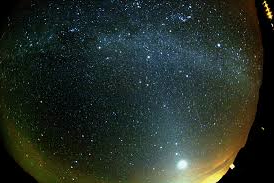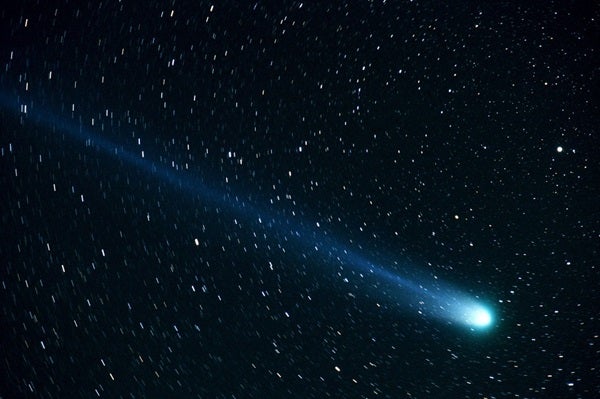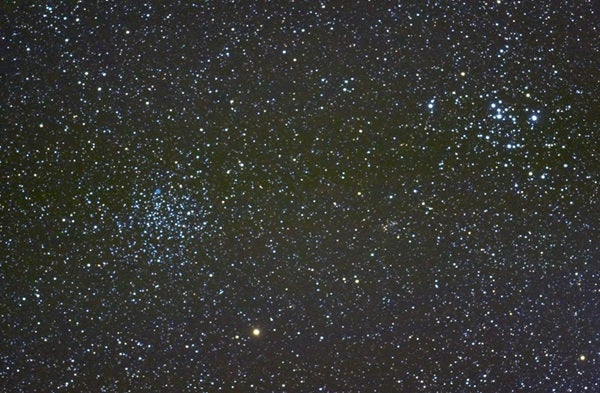Friday, February 17
Venus appears at its most brilliant today, shining at magnitude –4.8 (magnitude –4.85, to be more precise). That makes it 10 times brighter than the evening sky’s second-brightest object, Jupiter. The inner planet shows up easily in the west-southwest within a half-hour after sunset and grows even more prominent as darkness settles over the landscape. The planet lies among the background stars of Pisces the Fish, a region that stands nearly 30° high an hour after the Sun goes down and doesn’t set until 9 p.m. local time. When viewed through a telescope this evening, Venus appears 40″ across and 27 percent illuminated. A week from now, its disk will span 44″ and show a 20-percent-lit crescent. Although today marks the planet’s official peak in brightness, it doesn’t dip below magnitude –4.8 until early March.
Jupiter rises around 9:30 p.m. local time and climbs highest in the south about two hours before morning twilight begins. The giant world shines at magnitude –2.3 against the backdrop of central Virgo, some 4° north of that constellation’s brightest star, 1st-magnitude Spica. (The planet passes 4° due north of the star February 23.) Even a small telescope reveals Jupiter’s 41″-diameter disk and four bright moons. The planet also reaches an orbital milestone today. At 2 a.m. EST, Jupiter lies at its farthest point from the Sun during its 12-year orbit, at a distance of 507.2 million miles (816.3 million kilometers).
Saturday, February 18
Last Quarter Moon occurs at 2:33 p.m. EST. Look for it either before dawn this morning (when it lies among the background stars of Libra and looks slightly more than half-lit) or after it rises around 1:30 a.m. local time tomorrow (when it stands near the Scorpius-Ophiuchus border and appears as a fat crescent).
If the Last Quarter Moon looks a little smaller to you today, it may not be your imagination. Our satellite reaches apogee, the farthest point in its orbit around Earth, at 4:14 p.m. EST. It then lies 251,268 miles (404,376 kilometers) from Earth’s center.
Sunday, February 19
This week offers skygazers an excellent chance to see the zodiacal light. From the Northern Hemisphere, late winter and early spring are great times to observe this elusive glow after sunset. It appears slightly fainter than the Milky Way, so you’ll need a clear moonless sky and an observing site located far from the city. Look for the cone-shaped glow, which has a broad base and points nearly straight up from the western horizon, after the last vestiges of twilight have faded away. The Moon stays out of the early evening sky until February 28.
Monday, February 20
Comet 2P/Encke appears low in the western sky after darkness falls this week. The solar system’s busiest comet — it orbits the Sun once every 3.3 years, and this is its 63rd observed return — lies among the background stars of Pisces to Venus’ lower right. To find the comet, which should be glowing around 8th magnitude, first locate magnitude 4.0 Omega (w) Piscium. This evening, Encke lies some 2° east-northeast of this star.
Tuesday, February 21
Two of the finest deep-sky objects shine prominently on February evenings. The Pleiades and Hyades star clusters appear highest in the south as darkness falls but remain conspicuous until well past midnight. The Pleiades, also known at the Seven Sisters and M45, looks like a small dipper to naked eyes. The larger Hyades forms the V-shaped head of Taurus the Bull. Although both look nice with naked eyes, binoculars show them best.
Wednesday, February 22
The variable star Algol in Perseus reaches minimum brightness at 9:22 p.m. EST, when it shines at magnitude 3.4. If you start viewing it early this evening, you can watch it more than triple in brightness (to magnitude 2.1) over the course of a few hours. This eclipsing binary star runs through a cycle from minimum to maximum and back every 2.87 days. Algol appears high in the west after sunset and sinks low in the northwest after midnight.
Thursday, February 23
Saturn rises around 3 a.m. local time and climbs some 20° high in the southeast by the time morning twilight begins. The ringed planet shines at magnitude 0.5 and lies on the border between Ophiuchus the Serpent-bearer and Sagittarius the Archer. (It officially crosses the border from the former to the latter constellation today.) When viewed through a telescope, Saturn shows a 16″-diameter disk surrounded by a stunning ring system that spans 36″ and tilts 27° to our line of sight.
Friday, February 24
A pair of fine binocular objects shows up nicely on evenings this week. The open star clusters M46 and M47 reside about a degree apart in the northwestern corner of the constellation Puppis the Stern. The two lie about 12° east-northeast of the night sky’s brightest star, Sirius. The western cluster, M47, glows at 4th magnitude and appears as a fuzzy patch sprinkled with several pinpoint stars. Sixth-magnitude M46 shows up as a hazy collection of faint stars that is hard to resolve under most conditions. Although it contains nearly twice as many stars as M47, M46 appears fainter and fuzzier because it lies some three times farther from Earth.
Saturday, February 25
Asteroid 4 Vesta reached opposition and peak visibility in mid-January, but 2017’s brightest minor planet still shines at magnitude 7.0 and shows up easily through binoculars. To find the minor planet, start at magnitude 1.2 Pollux in northern Gemini and then drop 2.4° southwest to magnitude 4.1 Upsilon (u) Geminorum. Vesta lies 1.5° southwest of Upsilon this evening.
Sunday, February 26
New Moon occurs at 9:58 a.m. EST. At most New Moons, our satellite tracks across the sky with the Sun and remains hidden from view. But today, the alignment between the Moon and Sun is perfect and people in the right locales can view a solar eclipse. Observers across most of South America and southwestern Africa will see the Moon take at least a bite from the Sun. The best views, however, come along a narrow path that runs through southern Chile and Argentina before crossing the Atlantic and reaching the coast of Angola. People there will witness an annular eclipse. The Moon appears slightly smaller than the Sun in the sky, so observers along this central track will see a ring of sunlight surrounding the Moon. Because the eclipse is not total, people will need to use safe solar filters to view it directly.
Mars continues to put on a nice show these February evenings. It appears 25° high in the west once twilight fades to darkness, though it’s easier to find by looking 11° (about 1.5 binocular fields) to the upper left of brilliant Venus. The magnitude 1.3 Red Planet lies among the background stars of Pisces the Fish. Although this is normally a rather unremarkable region, it currently also hosts the distant planet Uranus. Mars passes just 34′ north of its 6th-magnitude neighbor this evening, and the two appear within 1° of each other both yesterday and tomorrow evenings. That’s close enough that both worlds appear within a single low-power telescopic field of view. Mars presents a 4.6″-diameter disk while Uranus, despite lying 10 times farther away, spans 3.4″. Neither object shows any detail, bit the ruddy color of Mars contrasts nicely with the blue-green of Uranus.












